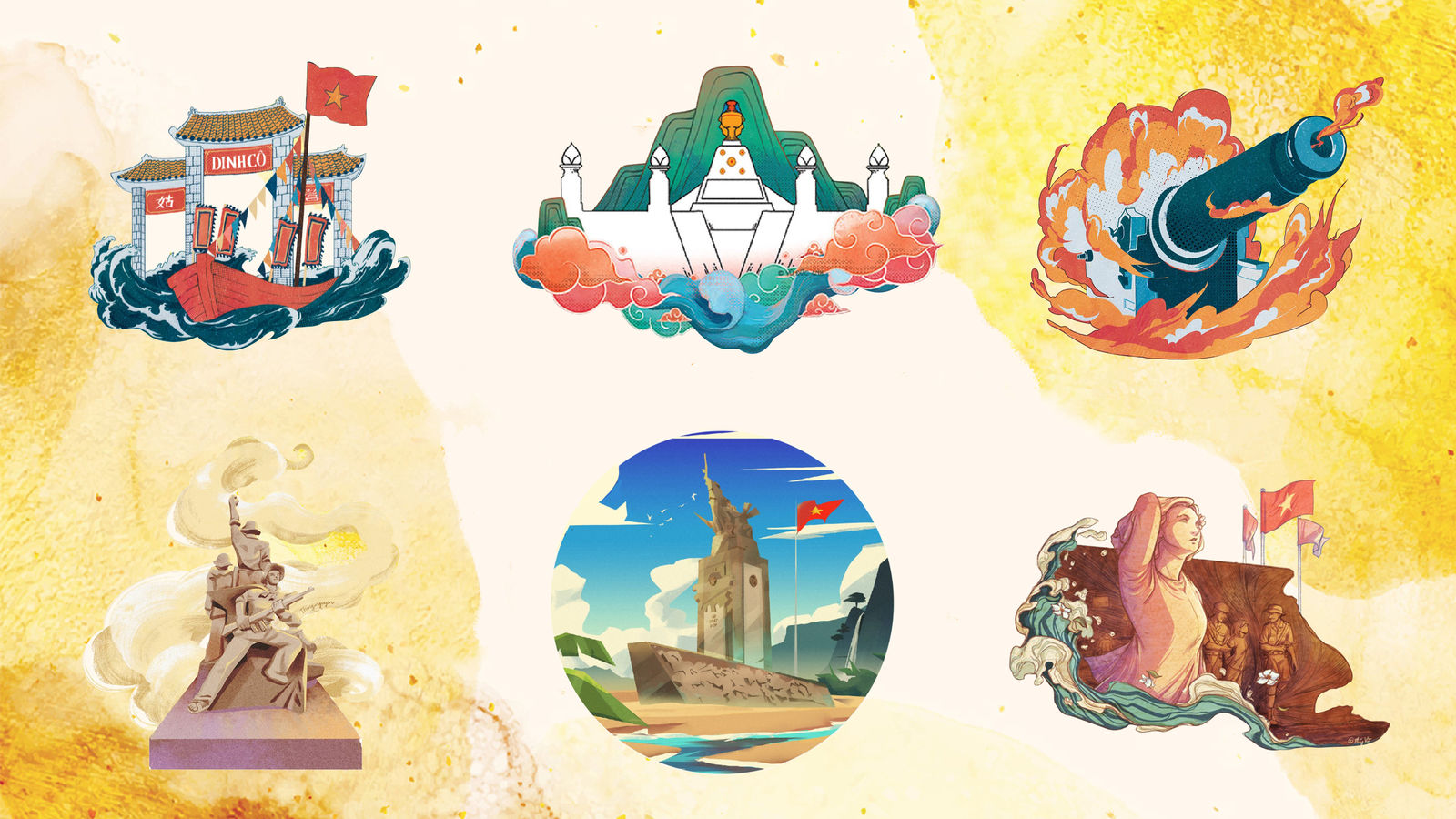Editor's note: This article is a personal essay written by Viktoria Grivina, a Ukrainian and friend of a member of our team. While Saigoneer has always focused our editorial content on Vietnam, as Vietnamese, we know first-hand how devastating and long-lasting the ramifications of war can be on a culture and nation, so we feel that it's important to give voice and provide support to war victims as best we can within our ability.
On February 24, I couldn’t fall asleep. In the middle of the night my phone lit up and a message from my friend popped up: “It was the right thing to worry.” Another friend wrote: “Explosions.” I tried to refresh the page of Hromadske, a popular Ukrainian news outlet, but most Ukrainian news websites were attacked by Russian hackers the moment our cities were attacked by Russian bombs. Explosions woke up every one of my friends in Kharkiv, Kyiv, and all across Ukraine. I went on a local Kharkiv social media channel that usually posts jokes and bizarre-looking people on the metro.

A street corner in Kharkiv in 2021. Photo by Kate Bezzubets via Unsplash.
“Kharkiv was bombed. The airport in Chuguiv destroyed. Explosions in the centre,” the site wrote. The message was followed by a meme of how Russian bots were flooding the channel and a note that comments would be closed for that reason. In those early hours, my body started to shake, even though I was far away. A month later, this strange trembling still continues. Two sentences ago, my hands were trembling; now it has stopped.
I called my dad’s number, our home number, but to no response. The official channel of our mayor said: “Please refrain from leaving your homes today.” When I finally reached my dad at around 8am, he said: "Oh, I’ve decided to go to work." He saw many Kharkovites spilling into the streets looking around their apartment buildings, confused; they talked to their neighbors and directed various curses to Belgorod — a nearby city in Russia from which the shelling came.
That was another first for Ukrainians: to experience sheer hatred and fury. February in Ukrainian translates literally to “furious.” If fury was fuel, Ukrainians would be the richest energy producer today. Kharkiv might be one of the most furious cities in Ukraine today.
With a population of over 1.6 million, Kharkiv is filled with Ukraine’s students, its IT industry, and nuclear physics. It's also the home of the biggest producer of instant noodles, Mivina, brought to us by Vietnamese businessman Phạm Nhật Vượng back in 1995. Mivina are the noodles that we used to eat at school breaks like crisps after smashing an unopened packet; it defined our poor but free existence.

A tragic before-and-after image. Image courtesy of Viktoria Grivina.
Kharkiv is my home. After I went away for a semester at St. Andrews University in the UK as a PhD student, I could never imagine that the city could be attacked. The last time any military action took place in the city was 1944. Now I’m seeing the old World War II photos come alive. I see the war through the eyes of my friends and family.
Nadya, my best friend from school, co-owns a trendy Asian fusion restaurant called GaGa. She sent me that first message. Like many Kharkovites, Nadya did not believe the full-scale invasion was happening. The night the bombing started, she didn’t even have her documents packed. She spent the first hours cleaning her apartment, where I also lived just a month before. It's located in a university area that's very central and full of international students, with parks and coffee shops, hip bars and a vibrant nightlife.
Many university buildings would be destroyed in the days to come, as the Russian military started looking for the biolabs falsely being reported on Russian news. On that first day, Nadya went to hide in the metro. Foreigners often wonder why Kharkiv underground platforms are so spacious. In fact, they were constructed as possible bomb shelters, the safest places in the city. But Nadya soon got cold and went to the Yermilov Contemporary Art Centre, a gallery situated in the cellars of the National University. This space also hosted Pavlo Makov, an artist whose 'Fountain of Exhaustion' will be presented in the Ukrainian pavilion at the upcoming Venice Biennale.

Nadya and her 1,000 portions of borscht. Photo via Instagram account @ga.ga.kharkiv.
To be inert is not something that Nadya is capable of, so after two days, she returned to GaGa with her team to start cooking for our military, territorial defense forces, hospitals, and people hiding in the metro. Several days later, the square next to GaGa was bombed. The cafe’s window was damaged, and the team decided to move to a smaller town away from the bombings where they were offered a bigger kitchen. Today, they are cooking over 3,000 meals a day for Kharkovites and are driving back and forth hundreds of kilometers to deliver the meals.
My other friend Nastya lives just a couple of streets away from Nadya. She spent the first days of the invasion in a bomb shelter under her house with her mom, the three cats she recently adopted, and a group of international medical students from India, Turkey and the United Arab Emirates. She admired them for fixing up the lights and creating comfort in the shelter by bringing carpets and furniture.
After the students were evacuated several days later, Nastya started to look after four more cats that the students left behind, hoping one day to return. She reopened her Etsy-only shop to post an option for donations, as she feared that it could become harder to feed everyone, though the students are also trying to help from abroad. She is an optimist, even though we exchange some of the most hard-breaking messages:

A message from Nastya. Image courtesy of Viktoria Grivina.
Most of my friends left Kharkiv — some on the first night, with a variety of adventures that deserve a story of their own. My parents stayed, though I am still asking them to leave. However, today’s roads can be as dangerous as the bombs, with Russian soldiers going mad from hunger and anger. They have shot several people that we know already. Kharkiv has to stand. There is no other option.
I also watched the city through the eyes of famous Kharkovites like Serhii Zhadan, a Ukrainian poet and writer. Not only did he stay, but he continues to document life, organize concerts and provide help across the city. In his eyes, Kharkiv is alive, even if wounded, filled with volunteers, freedom and hope. He has been nominated for this year’s Nobel prize by the Polish Academy of Science.
Another friend of mine, a young artist named Olia Fedorova, has become a media celebrity because of her choice to stay. She started a diary on social media, reporting on her life under bombardment and organizing guitar concerts with her neighbors. Olia’s partner joined the territorial defense, though it took him three attempts, as the lines to the recruitment offices were especially long in the first days.

Stepan strikes a lazy pose with an enormous exotic drink — a symbol of the chill spirit of Kharkiv.
Finally, we have a four-paw hero. In the face of horrific stories like the bombed zoo and Feldman ecopark where volunteers lost their lives while rescuing animals, one uplifting story has captured everyone’s attention. Stepan, a famous TikTok cat who lives in the heavily shelled Saltovka District, disappeared from social media for a while. People were alarmed, as Stepan and his lazy poses with enormous glasses of exotic drinks symbolize the chill spirit of Kharkiv. He returned on the third week of the war, reporting on his hardships in fleeing the city and getting across the Polish border to be saved by an association of influencers. He became a champion of helping Ukrainian animals.
As of today more than 600,000 people have left Kharkiv. Local authorities now ask civilians to leave and not risk their lives. All Kharkovites I know plan to return when the city is safe again. I am no exception. I have decided to return, either after victory, or when I feel that I will be needed to defend the city.
Famous Ukrainian linguist and writer Yury Shevelev, also a Kharkovite, once wrote an essay, "The Fifth Kharkiv," showing the history of the city, as if it went through a process of shedding skin like a snake. It was originally built as a fortress for Ukrainian warriors — Cossacks. Under the Russian Empire, it was reduced to a provincial town, then the university appeared, and Kharkiv became a hotbed of Ukrainian nationalism through the 19th century, and the first capital of Soviet Ukraine in the 1920s.

The main train station of Kharkiv. Photo by Yaroslav Romanenko via Unsplash.
During Stalin's rule, it was a place of tragedy, as many Ukrainian intellectuals were exterminated and Ukrainian farmers died of the imposed famine, called Holodomor. The loss of the Executed Renaissance — artists and writers who died for being Ukrainian in the 1930s — lead to the city slowly freezing into a gray and non-important Soviet town. Shevelev had to flee to the US, but predicted that the 'Fifth Kharkiv' was about to emerge — a new stronghold.
Kharkiv is a proud city, a jewel of Eastern Ukraine with a 200-year-old university, my alma mater, and hundreds of thousands of talented, tech-savvy young people. It was built as a fortress against nomadic conquerors from the south. Today it is once again a fortress that stands against invaders from the north. If Ukraine stands, Kharkiv, even wounded and hurting, has a bright future ahead.
GaGa is accepting donations to buy ingredients to make and provide meals. More details are available on their Instagram page here.
Help Nastya take care of the cats via her Etsy shop here.
[Poem image used in top image by Olia Fedorova]
Viktoria Grivina is a researcher and translator. She graduated from V.N. Karazin Kharkiv National University, majoring in English and German Linguistics. In 2020–2021, she was a research assistant at the project (Un)Archiving (Post)Industry, dedicated to the study of photo and video history of Donbas region. She's now at St. Andrews University working on her PhD research dedicated to the aesthetic and cultural transformations of Kharkiv.
















